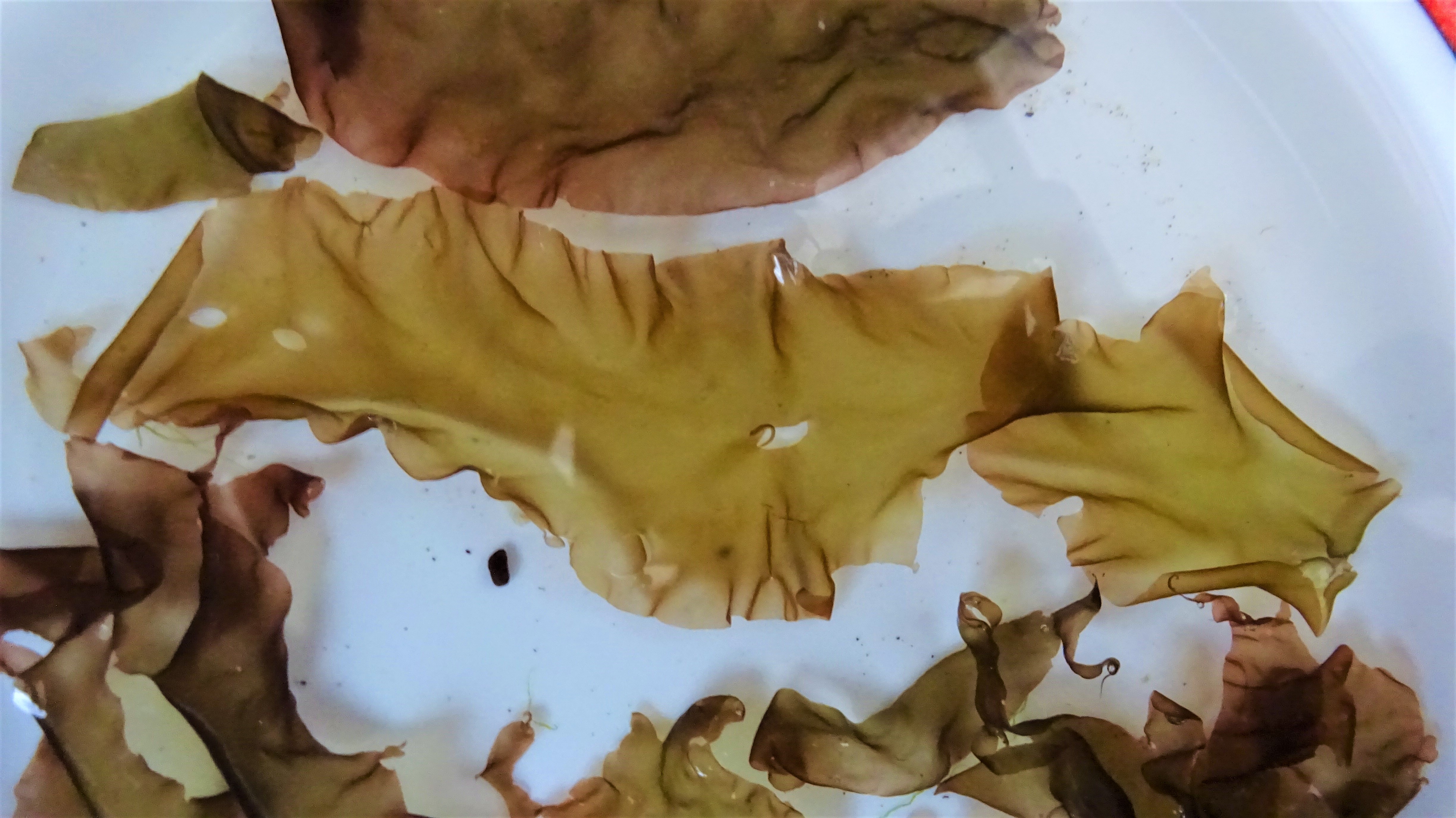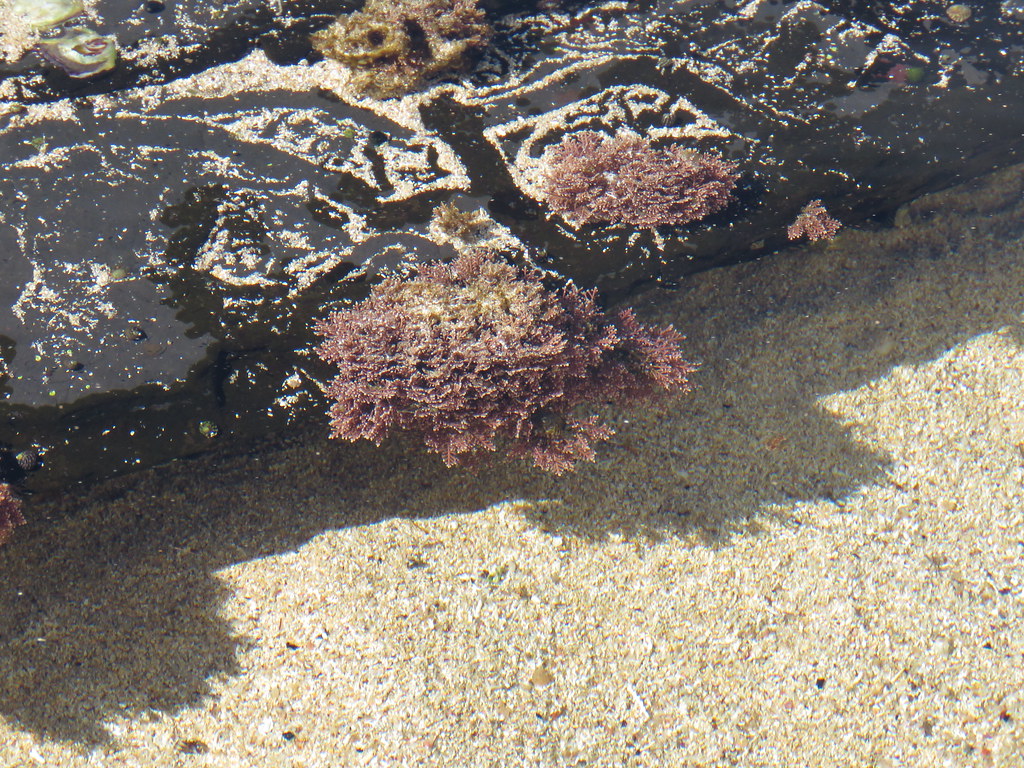With a few red algae examples we will discuss what red algae are and how they differ from other algae.
Red algae or Rhodophytes are eukaryotic algae with over 6000 species, of which most are marine except a few freshwater species like Batrachospermum etc. They are autotrophs and have a red color due to the presence of phycobilin pigments, I.e., phycoerythrin and phycocyanin. They are mostly autotrophic except a few like Harveyella, which are parasitic to other algae. Unlike other algae red-algae are sessile because they lack flagella.
A few common red algae examples are,
Bangia atropurpurea–
Division: Rhodophyta, Subdivision: Eurhodophytina, Class: Bangiophyceae, Order: Bangiales, Family: Bangiaceae, Genus: Bangia, Species: atropurpurea. They grow in the littoral intertidal zones of both freshwater and marine water. Filamentous body which is uniseriate at base and multiseriate above, is formed from unbranched, erect thalli.
Porphyra umbilicalis–
Division: Rhodophyta, Subdivision: Eurhodophytina, Class: Bangiophyceae, Order: Bangiales, Family: Bangiaceae, Genus: Porphyra, Species: umbilicalis. Growing in cold, shallow marine water; these edible algae are a type of Nori. It can reproduce both asexually, with help of spores or sexually using male and female gametes produced by single thallus. They are a rich source of vitamin B12.

Lemanea fluviatilis–
Division: Rhodophyta, Subdivision: Eurhodophytina, Class: Florideophyceae, Order: Batrachospermales, Family: Lemaneaceae, Genus: Lemanea, Species: fluviatilis. Found in temporal streams and rivers, these algae are native to Europe and North America.
Thorea ramosissima–
Division: Rhodophyta, Subdivision: Eurhodophytina, Class: Florideophyceae, Order: Thoreales, Family: Thoreaceae, Genus: Thorea, Species: ramosissima. These freshwater algae are distributed through temperate and tropical regions. They are small, filamentous and dark green in color and reproduces asexually.
Gelidium amansii–
Division: Rhodophyta, Subdivision: Eurhodophytina, Class: Florideophyceae, Order: Gelidiales, Family: Gelidiaceae, Genus: Gelidium, Species: amansii. Stiff, cartilaginous algae with compound lobed, pinnate leaves on each branch. This seawater alga is usually found in the East Asian shallow coasts and is an important part of Asian diet.
Ethelia hawaiiensis–
Division: Rhodophyta, Subdivision: Eurhodophytina, Class: Florideophyceae, Order: Gigartinales, Family: Cruoriaceae, Genus: Ethelia, Species: hawaiiensis. These mesophotic marine algae have large filament cells and their thallus cavity is often inhibited by microalgae.
Corallina officinalis–
Division: Rhodophyta, Subdivision: Eurhodophytina, Class: Florideophyceae, Order: Corallinales, Family: Corallinaceae, Genus: Corallina, Species: officinalis. These marine algae are found in lower or mid littoral zones on the rocky shores. They have a calcareous deposition within its cells and strengthen the thallus. It is used as a skincare product.

Platoma cyclocolpa–
Division: Rhodophyta, Subdivision: Eurhodophytina, Class: Florideophyceae, Order: Nemastomatales, Family: Schizymeniaceae, Genus: Platoma, Species: cyclocolpa. Thallus is gelatinous, slippery and pale red and are usually found in Western Pacific.
Gracilaria arcuata–
Division: Rhodophyta, Subdivision: Eurhodophytina, Class: Florideophyceae, Order: Garciliariales, Family: Garciliariaceae, Genus: Gracilaria, Species: arcuata. These agar yielding, marine algae are native to Indo-Pacific Ocean & Atlantic Ocean and grow in shallow sub-tidal zones attached to corals. Thallus is branched and cartilaginous and the plant is unisexual. They are used for human consumption and as wastewater purifier.
Rhabdonia spp–
Division: Rhodophyta, Subdivision: Eurhodophytina, Class: Florideophyceae, Order: Gigartinales, Family: Areschougiaceae, Genus: Rhabdonia. Thalli are erect, cylindrical or segmented into clavate of these marine algae. Each individual alga can grow up to 25 cm.
Champia lumbricalis–
Division: Rhodophyta, Subdivision: Eurhodophytina, Class: Florideophyceae, Order: Rhodymeniales, Family: Champiaceae, Genus: Champia, Species: lumbricalis. These marine, worm like algae are native to South Africa.
Ceramium affine–
Division: Rhodophyta, Subdivision: Eurhodophytina, Class: Florideophyceae, Order: eramiles, Family: ceramiaceae, Genus: Ceramium, Species: affine. They are small, dioecious, marine algae that are consisted of a terete of single row of cells surrounded by smaller cells forming cortex.
Chondrus crispus–
Division: Rhodophyta, Subdivision: Eurhodophytina, Class: Florideophyceae, Order: Gigartinales, Family: Gigartinaceae, Genus: Chondrus, Species: crispus. These soft and cartilaginous marine algae is commonly known as Irish moss. They grow on the surface of rocks, from intertidal zone to all the way to the sea floor and can survive in minimal light. They are found in Northern Atlantic and are commonly edible, also used as medicine.

Cyanidioschyzon merolae–
Division: Rhodophyta, Subdivision: Eurhodophytina, Class: Bangiophyceae, Order: Cyanidiales, Family: Cyanidiaceae, Genus: Cyanidioschyzon, Species: merolae. A primitive, unicellular alga, commonly found in hot springs. This eukaryotic cell is a model cell to study cell & molecular biology and bio-technology because of having an extremely simple, compact genome of 16.5 Mbp containing 5,331 genes.
Palmaria palmata–
Division: Rhodophyta, Subdivision: Eurhodophytina, Class: Florideophyceae, Order: Palmariales, family: Palmariaceae, Genus: Palmaria, Species: palmata. These sessile, marine cold-water algae have a leathery texture and is commonly called Dulse or Irish seaweed. They are usually found in different shores throughout Europe and North Atlantic shore of America. Dulse is consumed as food due to its rich mineral content.
Mastocarpus stellatus–
Division: Rhodophyta, Subdivision: Eurhodophytina, Class: Florideophyceae, Order: Gigartinales, Family: Phyllophoraceae, Genus: Mastocarpus, species: stellatus. These red algae are also known as carrageenan moss or false Irish moss and generally found in coast of Ireland and Britain. They can tolerate high environmental stress. It is used as a food item because of its high antioxidant content and also being used as a plastic substitute.
Also Read:
- Plant like protists examples
- Aquatic ecosystem example 2
- Do protists move
- Are protists bacteria
- Do eukaryotic cells have mitochondria
- Can plant cell have cytokinesis
- Spider examples
- Cytoplasm function in animal cell
- Do fungi have ribosomes
- Is chloroplast an enzyme
Hi…..I am Pratyush Das Sarma, I have completed my Master’s in Biotechnology. I always like to explore new areas in the field of Biotechnology.
Apart from this, I like to read and travel.
